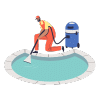The Ultimate Guide to Pool and Spa Maintenance
Everybody loves the idea of a backyard pool or spa, but who wants to maintain them?
We understand. A stunning spa or pool in your backyard is a luxury. In this private oasis, you can escape, relax, and enjoy your time with family and friends.
But it’s frustrating to slip into your spa or dive into a pool after a long, stressful day, only to find that the water is murky, the pumps aren’t working correctly, and it just doesn’t have that inviting, clean feeling anymore.
At Keystone Custom Decks, we believe you deserve to enjoy the benefits of a well-maintained pool, and it doesn’t have to be a hassle!
That’s why we’ve created this guide to pool maintenance, focusing on regular cleaning and sanitization, water quality, equipment inspection, and seasonal shutdown and startup.
Understanding the Difference Between a Pool and a Spa
Before we begin, let’s clarify the difference between a pool and a spa. A pool is a large, man-made body of water that is generally unheated and large enough for people to swim in. Typically, pools are at least 100 square feet.
A spa is like an oversized jacuzzi—essentially a hot tub large enough to swim in. Spas are heated and may or may not have jets.
Now that we understand what we’re talking about, let’s focus on maintenance issues.
The Importance of Routine Maintenance
Spas generally require less maintenance than pools. A pool needs a lot of maintenance because you have to balance the chemicals and keep them clean. Spas often have filters and antimicrobial covers, which means less need for continuous care. Both can have algae problems, but pools are more difficult because they are bigger and have more surface area.
Establishing a consistent maintenance routine is essential. Much like how you regularly clean your home or service your car, your pool or spa requires regular attention to maintain its pristine condition. The benefits of a routine maintenance schedule include:
- Prolonging the lifespan of your pool or spa equipment
- Ensuring health and safety for your family
- Maintaining clear and enjoyable water
- Reducing long-term costs by preventing significant repairs
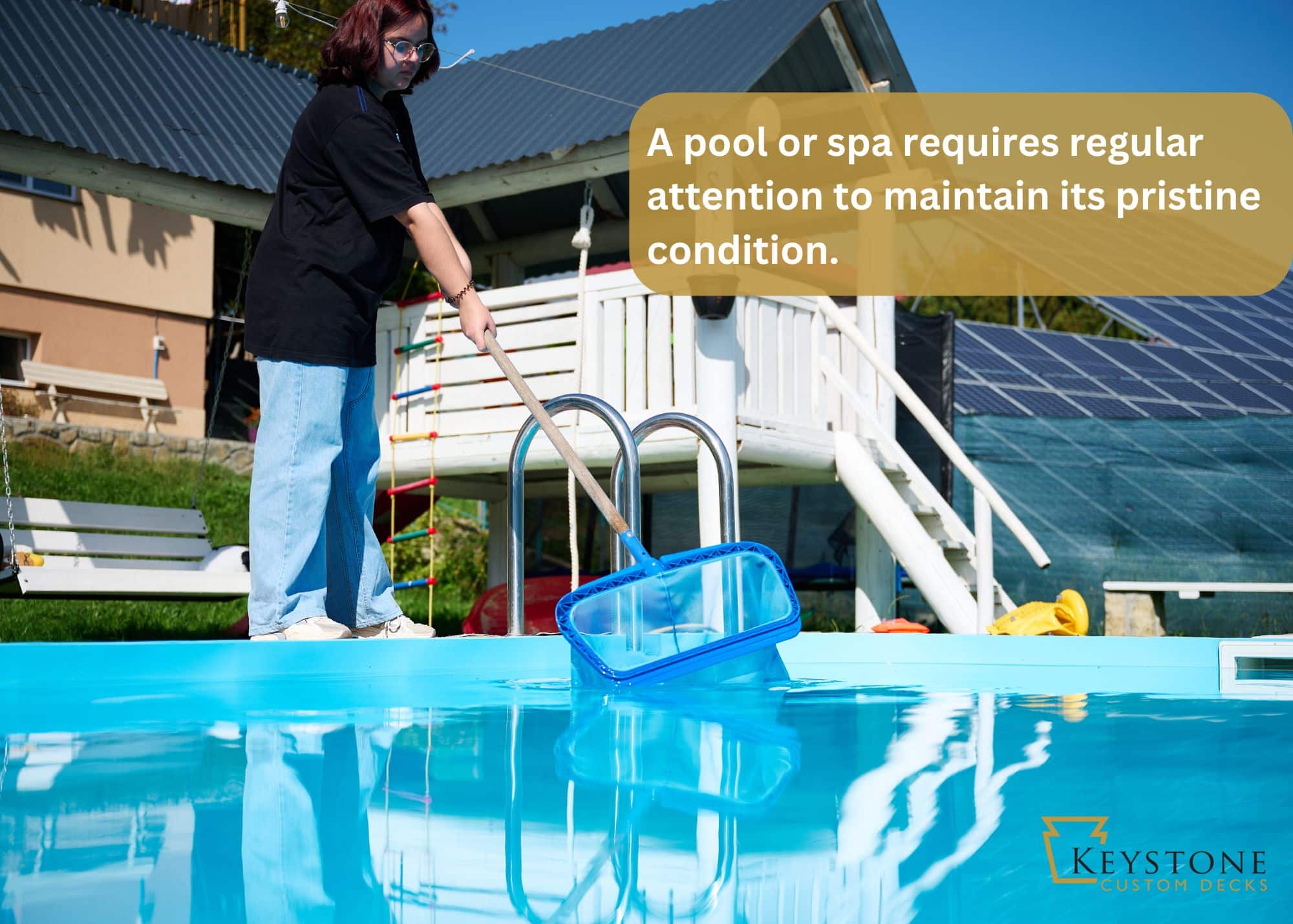
Once you establish a rhythm, regular upkeep is easy to maintain. It’s all about developing a checklist and knowing what to look for and when.
Here’s how it works:
Regular Cleaning and Sanitization
Your spa or pool is a sanctuary, a place of relaxation. Keeping it clean and sanitized is the cornerstone of effective maintenance. Regular cleaning prevents the buildup of harmful bacteria and ensures a hygienic environment for users. Here’s how to maintain your pool or spa:
Daily Tasks:
- Skimming: Skim your pool daily using a fine mesh to remove floating debris such as leaves, bugs, and dirt. This will prevent debris from sinking to the bottom, making cleaning more manageable and preventing stains.
Weekly Tasks:
- Check Filters: Clean or replace filters as needed to ensure the water circulates properly.
- Surface Cleaning:
- Depending on how often your pool is used and its location (e.g., surrounded by trees), you should vacuum your pool at least once a week. Options include manual vacuums, automatic vacuum cleaners, or robotic pool cleaners, all of which offer varying degrees of convenience and effectiveness.
- Don’t forget the tiles and pool walls. Brush them weekly to eliminate algae and calcium buildup.
- Use a non-abrasive cleaner to wipe down the spa surfaces, preventing the buildup of grime and scale.
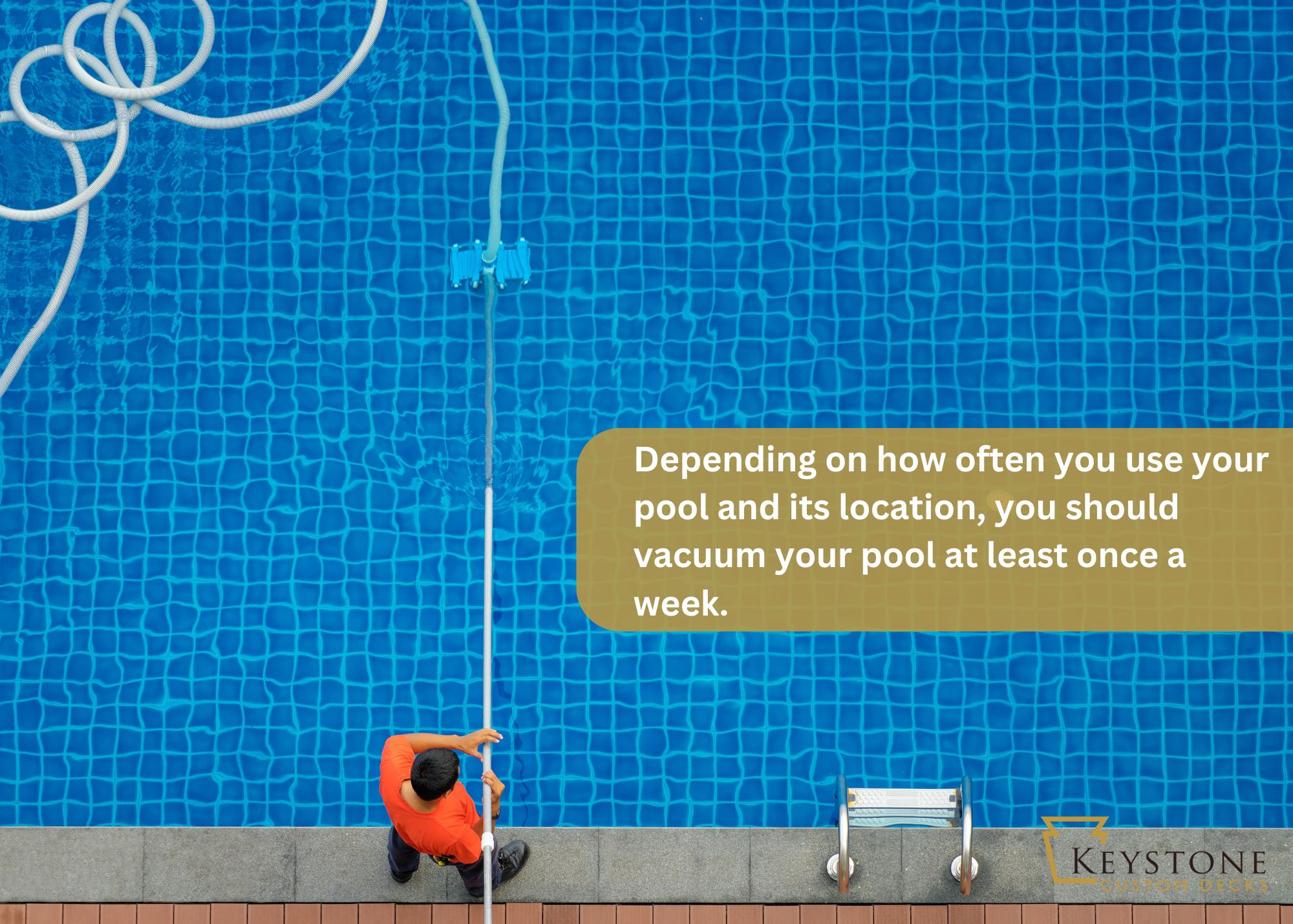
Monthly Tasks:
- Flush Plumbing Lines: Purchase a plumbing cleaner to flush out the pipes, ensuring no biofilm or contaminants lurk inside.
- Deep Clean: Consider thoroughly cleaning the entire pool or spa, including removing and scrubbing any jets. Signs that your pool or spa needs a deep clean include a strong smell of chlorine, cloudy or green water, foam, and skin or eye irritation after swimming.
Regular cleaning keeps your pool or spa looking good and extends its lifetime. Routine maintenance reduces the likelihood of costly repairs down the line.
Balancing pH and Chlorine Levels
Maintaining a balanced pH and chlorine level in your pool or spa is crucial for ensuring the water is safe for swimming. Unbalanced water can lead to cloudy water, algae growth, and even skin irritation. Here’s how you can keep these levels in check:
- Testing the Water: Regularly test the pH and chlorine levels using a testing kit. Aim to check at least twice a week. The ideal pH level is between 7.4 and 7.6, while free chlorine levels should remain between 1 and 3 parts per million (ppm).
- Adjusting Levels: Add a pH reducer if the pH is too high. If it’s too low, use a pH increaser. To adjust chlorine levels, use chlorine tablets or liquid chlorine as needed. Remember, extreme temperatures, heavy rain, or heavy pool usage can quickly alter these levels, so adjustments may be necessary more frequently during certain seasons.
- Total Alkalinity and Calcium Hardness: To stabilize pH levels and prevent corrosion or scaling, maintain total alkalinity levels between 80 and 120 ppm and calcium hardness between 200 and 400 ppm.
For a more comprehensive understanding of water chemistry, check out Keystone’s earlier post, Considering an Inground Pool? 7 Frequently Asked Questions Answered, which offers insightful tips on pool maintenance basics.
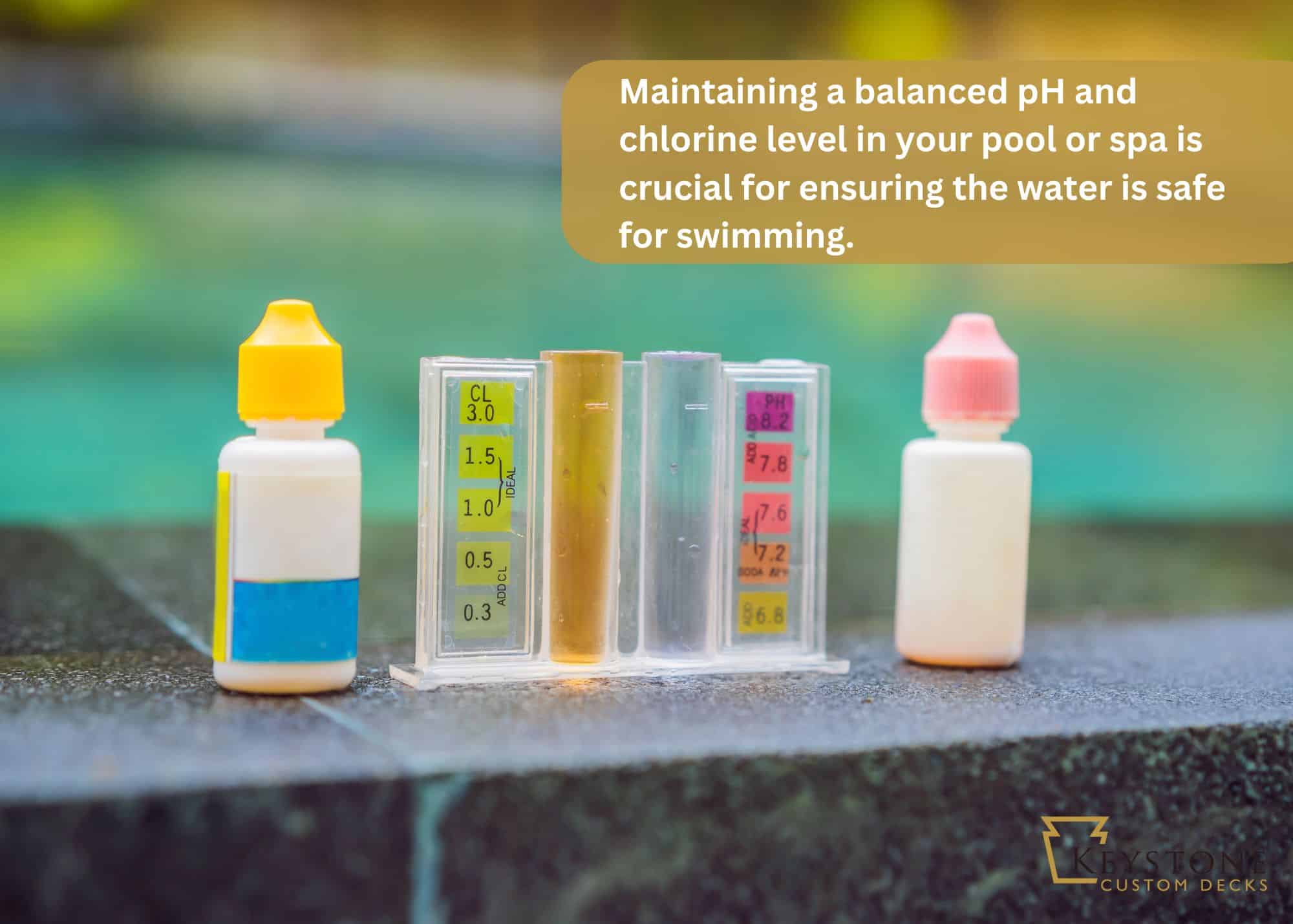
Equipment Inspection and Repair
Can I be totally honest with you?
Even with the best of care, components wear out over time. Regular inspections help identify minor issues before they become costly problems.
For a pool, this includes:
- Pumps and Motors: These are the heart of your pool’s circulation system and should be inspected at least once a month. Check for noise, leaks, and overheating. Clean the pump basket regularly.
- Filters: Maintenance tasks will vary depending on the type of filter you have (sand, cartridge, or diatomaceous earth). Cartridge filters should be cleaned every two to six weeks, while sand and diatomaceous earth filters typically need annual attention.
- Heaters and Chlorinators: Ensure that heaters ignite correctly and that chlorinators consistently feed chlorine into your pool. Regular descaling and cleaning are crucial to prevent blockages.
- Plumbing: Inspect the plumbing system for leaks. Even small leaks can lead to significant water loss over time and might indicate a more serious problem.
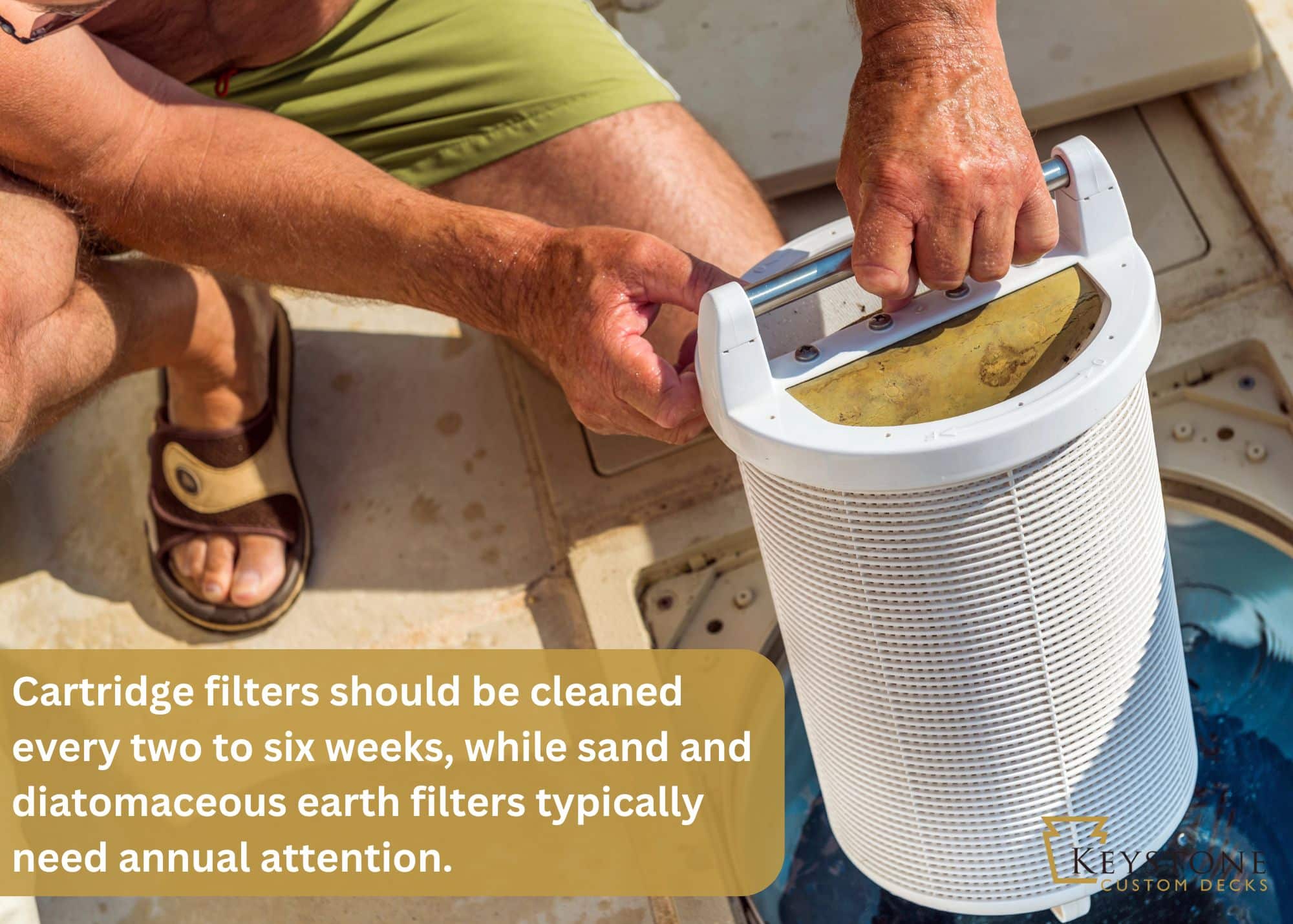
For a spa, check these things:
- Pumps and Heaters: Inspect these multiple times per year for noise or performance issues.
- Jets: Ensure that jets are clear and efficiently delivering water, as clogged jets can significantly diminish your spa experience.
- Cover: A damaged spa cover may allow debris into the water and negatively affect energy efficiency. Regularly check for tears or waterlogging.
Regular inspections improve your pool’s longevity and save you money by identifying potential issues before they become expensive repairs.
Seasonal Maintenance Tips
The changing seasons bring unique challenges and opportunities for maintenance.
Each season requires specific tasks to keep your pool in optimal condition.
- Spring: Time to open your pool. Remove the cover, inspect for damage, and give the pool a deep clean. Rebalance chemicals and inspect all equipment.
- Summer: Peak use months require vigilant attention. Skim and vacuum regularly, and check the water chemistry more frequently due to increased use and higher temperatures.
- Fall: Clear out fallen leaves to prevent clogging the filtration system. Consider investing in a cover to protect your pool from debris during this season.
- Winter: If you winterize your pool, lower the water level, drain and store equipment, and add a cover. If you keep it operational, continue maintaining chemical balance and equipment.
Properly preparing your spa for the changing seasons is equally crucial.
Winterizing Your Spa:
- Drain the Water: Completely empty the spa to prevent any water from freezing and causing damage.
- Blow Out the Lines: Remove any residual water from the plumbing lines using a wet-dry vacuum.
- Cover Securely: Use a high-quality cover and consider adding a thermal blanket for extra protection.
Starting Up for Summer:
- Inspect All Components: Before refilling, ensure all parts, including pumps, heaters, and seals, are in good condition.
- Refill and Balance Chemicals: Once the spa is filled, give it a complete cycle of chemicals to balance the water.
- Test Run: Run all jets and features to make sure everything functions properly.
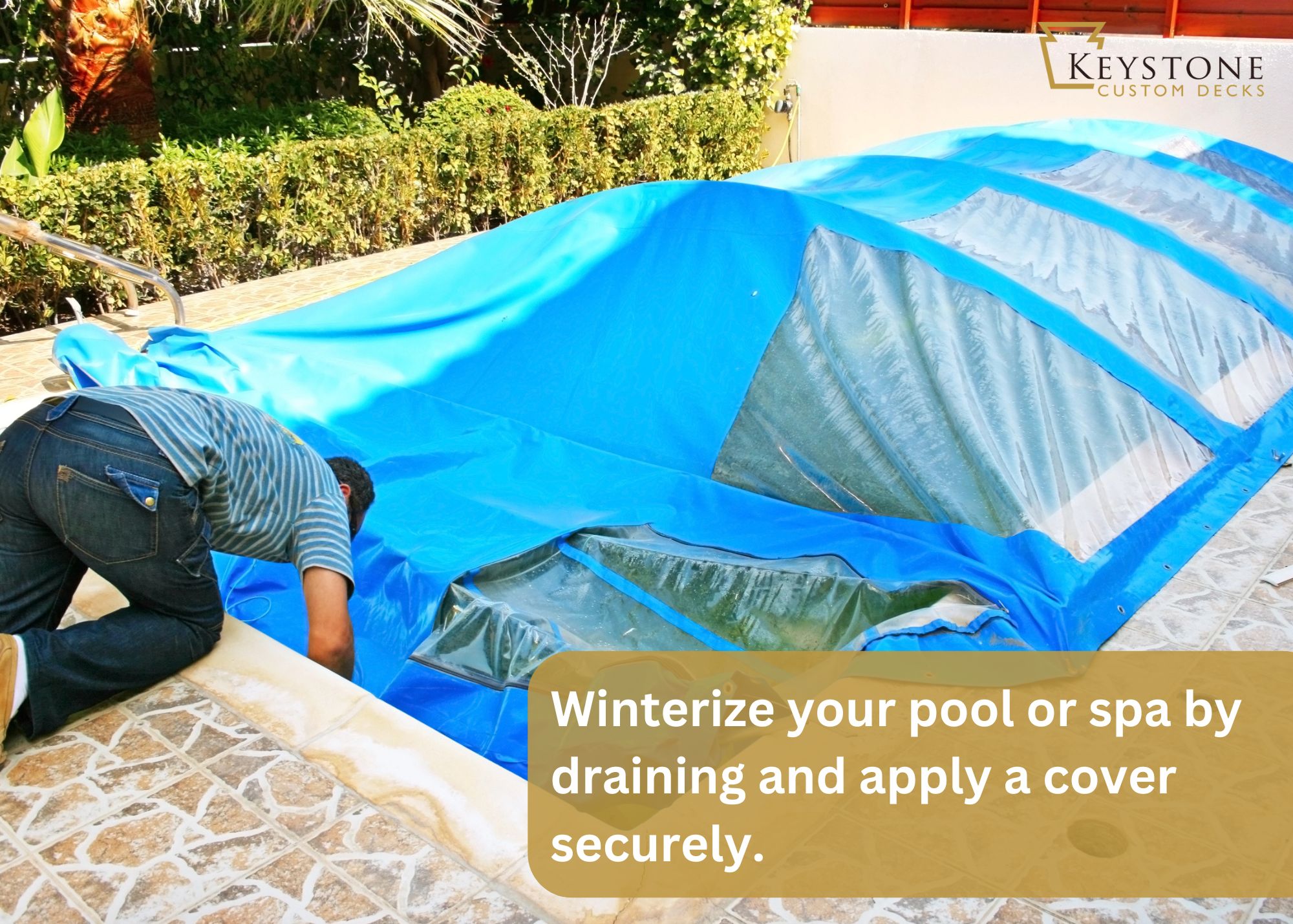
Professional Maintenance Services
If all this talk about maintenance makes you tired, don’t worry.
Sometimes, a little help from the professionals can be invaluable. Professional maintenance services like Keystone Custom Decks provide several benefits:
- Expertise: Trained technicians can identify and solve issues that you might miss.
- Proper Tools and Techniques: Professionals have the expertise and tools to handle complex maintenance tasks and repairs.
- Consistency: Regularly scheduled visits ensure consistent upkeep.
- Peace of Mind: No need to worry about balancing chemicals or inspecting equipment; it’s all taken care of.
Yes, you read that right! If you’re considering outsourcing your pool maintenance, you can let Keystone Custom Decks do all the work. Our team can help you maintain your pool so you can spend more time enjoying it.
Bringing It All Together
And that’s it!
Maintaining your pool or spa involves establishing a routine cleaning schedule, balancing water chemistry, performing equipment inspections, and preparing for seasonal changes.
For further reading and more in-depth tips on maintaining various aspects of your outdoor living space, feel free to check out these additional posts on our blog:
- Creating a Family-Friendly Outdoor Living Space
- Elevating Your Short-Term Rentals with a Pool
- How To Design A Gorgeous Covered Porch: 6 Helpful Questions To Ask Yourself
When it comes to maintaining your pool or planning your next outdoor living project, trust the experts at Keystone Custom Decks. With a commitment to high-quality materials, superior customer service, and flawless workmanship, your dream outdoor space is just a step away.
Give us a call today to customize your service package.






